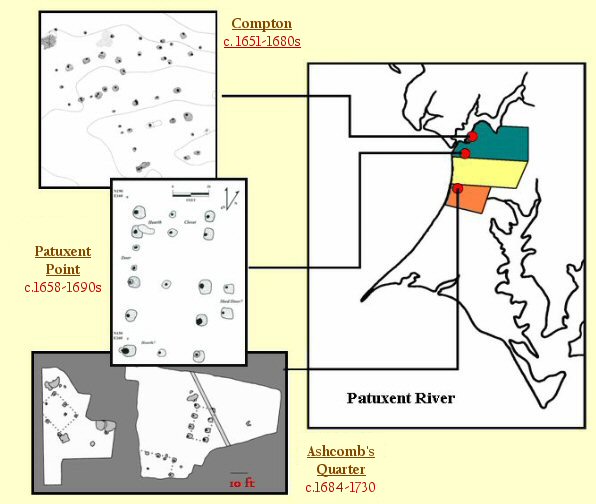17th & 18th Century Architecture Along the Patuxent River, MD
Essay by Sara Rivers Cofield, 2007
Site Cluster 2 Discussion and Summary

While Compton, Patuxent Point, and Ashcomb’s Quarter each have their own unique characteristics, the similarities in this area abound. All three sites have post-in-ground structures, wood-framed wattle and daub chimneys, and a few window leads indicating some glazing. With the exception of a possible small root cellar at Patuxent Point, there are no interior storage features, which could also indicate that there was no plank flooring as would have been necessary to cover such cellars. The absence of plaster indicates that all three had plain plank walls. There are no tiles of any kind, and brick is so scarce that it has been interpreted as being used for fire boxes only (Gibb 1994). At Compton and Patuxent Point, enough of the brick was Dutch yellow brick to imply that the inhabitants were obtaining masonry from overseas traders and may not have had much access to locally manufactured brick.
The similarities between these sites are striking, but not surprising given the commonalities among the people who settled them. Both Compton and Patuxent Point were likely built by fairly well-to-do settlers, but neither William Stevens or John Obder ultimately made this area their home, as both were living on the Eastern Shore of Maryland where land was more available by the mid-1660s. Fertility of the land on the Eastern Shore may have been a draw for the wealthier planters, since cultivation may have already stripped the soils on the smaller parcels such as Compton and Patuxent Point (Gibb 1994:176). Similarly, Ashcomb’s Quarter was controlled by an owner on the Eastern Shore who did not occupy the site (Catts et. al. 1999).
All three sites appear to have offered persons of means very little opportunity to grow wealth, and instead they were used by tenants and slaves to make a living after the owners had moved on. The sites’ occupants adopted similar cheap, bare-bones building techniques, and maintained those buildings rather than investing in new construction. Compton and Patuxent Point were abandoned at some point around the time of the tobacco depression. It is not terribly strange that Ashcomb’s Quarter is so similar to those sites even though it was built so much later. Macroplant analysis at Ashcomb’s has indicated that there was a move towards grain cultivation there, but the occupants were not likely to have benefited as much as the landlord from any increased profit that might have generated. There is no progression in this area to brick or frame architecture. Instead, the trend was mostly towards abandonment, as all of the inhabitants eventually died or moved away.
If you have any questions or comments about this article, or sites and artifact collections discussed, please contact:
[email protected].